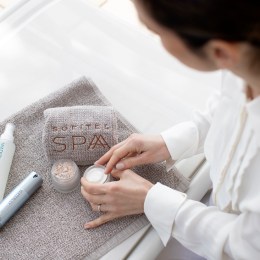Can a natural ingredient be classed as a cosmeceutical? Sure! After all, when exactly did the biochemistry that exists in natural plant compounds cease to be science? Michelle Reeve* explains.
Our ageing population is demanding beautiful, luminous skin lifelong. While topical procedures such as injectable fillers can correct structure, they do not necessarily change the quality of the skin.
When consumers seek out corrective and remedial results, cosmeceuticals are the known cornerstone of active ranges.
A “ceutical” refers to a product that holds medicinal properties, and the aesthetics industry has evolved to recognise a broad variety of ingredient types responsible for contributing to the efficacy of cosmeceutical skincare.
These are products claiming to have, and should be able to seriously justify, measurable therapeutic benefits to the skin.
As consumers increasingly gravitate towards natural products – those without synthetic chemicals and particularly the known “nasties” – a naturopathic approach where the integrity of the skin is embraced holistically is gaining popularity.
An integrated outlook respects the complexity of biochemically-available nutrients while considering lifestyle factors, gut health and the inter-connectedness of our other body systems.
The skin is our fastest-growing organ, with the epidermis renewing itself every two to four weeks. It’s also our largest organ, weighing in at a hefty 3.5kg!
The nutritional needs of our skin are extensive and consumers are appreciating that this organ is not indifferent to the natural laws of biology that govern every other body system.
Just as we would no sooner subject our gut to artificial food sources and aggressive chemical compounds, why would we assume our skin would not be compromised by the same synthetic ingredients?
Although the skincare landscape is evolving, recent history has seen commercially-prepared cosmetics’ enthusiastic use of tallow, whale fat, petrochemicals and mineral oil bases with synthetic actives.
Trademarked compounds with intergalactic acronyms packaged with upward-trending bar graphs were presented as the holy grail of anti-ageing.
The claim of a patented synthetic ingredient was a marketing win guaranteed to boost commercial viability and enable product credibility.
Now cosmeceutical ingredients are not only tested to their longer term effect on oxidative stress, barrier function, nutritional support and sensitivity, but are also measured on the synergy of other ingredients in the mix.

So, can a natural ingredient be classed as a cosmeceutical? Sure! After all, when exactly did the biochemistry that exists in natural plant compounds cease to be science?
Biochemistry and the potent array of nutrient-rich plant actives that can be harnessed to maximise the therapeutic benefits of skincare are overwhelming.
“Biomimicry” was once seen as science trumping nature. When we consider the intricacy that exists in a single botanical ingredient and the interwoven synergy created by hundreds of individual chemical constituents, how can we possibly expect a single patented compound to compare?
By trying to recreate nature we have poorly reinvented the wheel in the effort to dazzle consumers with the promise of “science”.
Let’s consider how natural cosmeceutical actives fit in the picture.
Lactic acid is a great example, the byproduct of fermenting lactose, a naturally-occurring milk sugar converted to a simple carbohydrate.
Its known topical effects on the skin – apart from the obvious kerolytic benefits – is a proven ability to stimulate collagen synthesis.
That’s truly fabulous, but here’s the thing: what’s the point of stimulating collagen production if the building blocks to create healthy collagen are not in abundant provision?
Collagen requires essential fatty acids, vitamins and antioxidants not only to build healthy connective tissue but protect it from oxidative stress, free radical and UV damage along with the environmental pollutants that cause degradation.
Without these other essential ingredients we are only doing half the job. Healthy skin formulations are not just relying on the “ceutical” content but utilising bioactive naturopathic-style ingredients as the foundation of the formula.
Cosmetic offerings can be broadly divided into two distinct families:
- Remedial and corrective ranges, not unlike an antibiotic prescription from a doctor to remedy an infection.
- Maintenance lines, similar to the way we’d view a supplement or vitamin from a naturopath for longterm nutritional health and vitality.
Ceuticals are now acknowledging powerhouse bioactive nutrients bestowing dual rewards. Examples include antioxidant super stars like vegetable concentrates, coenzyme Q10, resveratrol, alpha lipoic acid and potent vitamins.
Educated consumers are honing their ingredient savvy skills and the discussion is putting actives under the microscope: What is the ingredient exactly? What is the concentration? What is the delivery system? How was it sourced and what was the method used for extraction?
The ingredient source and complete chemical profile along with the methods used to activate transdermal penetration are now forging a vigorous conversation around product effectiveness and results.
Ingredient suppliers are also honing their technology with the focus on extraction methods being as important as the nutritional signature of the ingredient itself.
Food appeal is no longer the sole domain of digestion. Ingredients like broccoli and kale are not just used as a label listing but using nature identical extraction methods can be exploited to deliver skin-protecting benefits.
Technology is taking the potent concentrates curated by nature and delivering them in a format that protects their chemical identity and integrity thereby boosting their therapeutic benefits to the skin.
Nutraceutical delivery systems are also being channelled to infuse fat soluble vitamins, antioxidants and omega plant oils to the skin topically.
The benefits are not only a safer and more natural technique offering increased stability and purity of ingredient but, excitingly, clinical trials are demonstrating deeper transdermal penetration with longer lasting activity.
The belief in a single bullet active is beginning to wane. Unlocking phyto-active ingredients delivers a broad spectrum of naturally occurring essential minerals, vitamins, antioxidants, enzymes, lipids and trace elements in concentrations rich enough to both support and correct skin.
Using whole plant extracts instead of replicating only the key active offers a complex chemical plant profile with the added benefit of being biochemically compatible with the skin.
With the product variety on offer how can therapists navigate their way to deliver an effective home care prescription for clients looking for real results? Here are what I feel are the key considerations when looking for a “ceutical” solution:
- The active ingredients need to be present in clinically-trialled doses to deliver therapeutic benefit. This needs to disclosed and reinforced within the label listing.
- A broad range of nutrients needs to be present in effective concentrates in a transdermal delivery system. Let’s remember that no single ingredient can be solely relied upon to deliver all of the nutrients required for great skin.
- There can be no compromise on an omega-based delivery system. Inflammation is the precursor to all skin disorders and essential fatty acids are vital to optimal skin health.
- Bioactive plant-based “ceuticals” are not celebrating natural because they are deemed “safe”. These are the formulation ingredients that comprise the same biochemical building blocks found within us. Our cells have the innate capability to recognise, metabolise and uptake their benefits, enabling beautiful healthy skin lifelong.
* Aromatherapist and natural medicine advocate, Michelle Reeve is the founder and formulator for the botanical Australian spa brand, Waterlily. SPACEUTICALS is the newest retail addition to the Waterlily collection, created by combining advanced cosmeceutical actives, antioxidants and vitamins with potent botanical concentrates. Waterlily is stocked in leading day spas and salons nationally.




